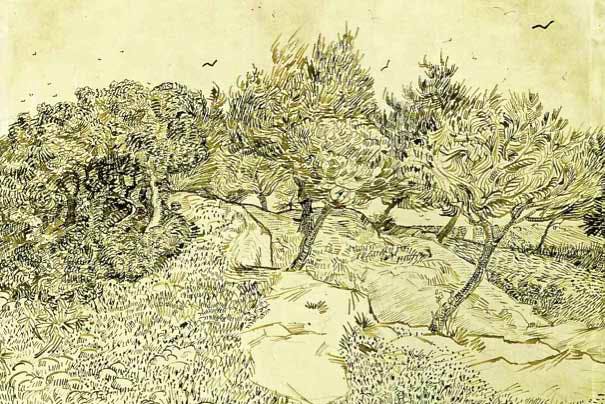When I am far away from Mallorca, remembering the brilliant sunshine and azure skies, one of the subjects that I always think of as "my next project" is the olive trees. Their feather-like silver leaves and gnarled trunks talk of endurance, elegance, lightness and in truth, the essence of the Mediterranean.
The olive, Olea europaea, is now widespread around the world as an important crop for olive fruit and olive oil, but its origins go back to some 20-40 million years ago when it was growing in what is now Italy and the eastern Mediterranean area. We know that man has been actively cultivating these trees for roughly 6000 years, because they are mentioned on ancient tablets and their pits have been found even in tombs. Olive oil is mentioned in very early cook books, particularly in Crete, where olive cultivation probably contributed hugely to the wealth of the 300 BC Minoan civilisation. Fossilised olive leaves from about the same time have also been found on nearby Thera/Santorini. No wonder the ancient Greeks used olive oil on their bodies. Olive trees have long been considered sacred, symbols of wisdom and power.
It is hardly surprising that artists have long been fascinated by olive trees. I know that personally, I keep returning to these trees, whenever I can, because their power and endurance are inspiring. Many artists have painted them, especially at the end of the nineteenth century or early twentieth century, when the plein air movement was fully established and artists were frequently inspired by mighty trees. Interestingly, one of the most famed plein air artists of the late nineteenth century, Paul Cézanne , seemed to respond far more to pines and other trees, rather than olives, which he must have seen in the south of France in his area. Nonetheless, looking closely at one of his most revered landscapes, there is most likely an olive tree in the middle distance, towards the left of the painting, by the building.
The François Zola Dam, 1877-78, Paul Cézanne , oil on canvas, (Image courtesy of the National Museum of Wales.)
Claude Monet explored olive trees' possibilities in 1884 when he spent time in the south of France at Bordighera, a pretty little town on the Italian Riviera.
Olive Trees (Study), 1884 by Claude Monet
Claude Monet Olive Trees in Bordighera, 1884 oil.j
Very soon afterwards, another visitor to the south was Vincent Van Gogh, and in 1888-89, he painted some fourteen canvases of these gnarled and twisted trees which perhaps echoed his state of mind while he was in the asylum at Saint-Rémy.
Olive Trees, oil on canvas, Vincent Van Gogh, 1889, (Image courtesy of National Galleries of Scotland)
Olive Grove with two olive pickers, V. Van Gogh, (Image courtesy of Collection Kröller-Müller Museum, Otterlo, Netherlands)
Olive Trees with yellow sky and sun, Saint Remy, November 1889, V. Van Gogh, (Image courtesy of Minneapolis Institute of Art)
Van Gogh also did at least one wonderful drawing of olive trees while he was at Saint-Rémy.
Olive Trees (1888), Vincent van Gogh (Courtesy of the Musée des Beaux-Arts, Tournai.)
After Van Gogh came any number of artists. Even visiting American artists like Theodore Robinson fell under their charm.
Olive Grove, Capri, 1890. Theodore Robinson (Image courtesy of Colby College Museum of Art)
Henri Matisse returned to this subject many times, trreating the trees in interestingly different fashion as time passed.
Henri Matisse - Olive Trees, 1898, (Image courtesy of Pushkin Museum of Fine Art, Moscow)
Olive Trees at Collioure, c 1906, oil on canvas, Henri Matisse, (Image courttesy of Metropolitan Museum)
Conversation under the Olive Trees, H Matisse, 1921 (Image courtesy of Carmen Thyssen-Bornemisza Collection on loan at the Museo Nacional Thyssen-Bornemisza)
John Singer Sargent visited Corfu in 1909 and got all excited about the olive trees there, something I can readily understand as they are magnificent. The trees are allowed to grow to their natural height without pruning and the olives are allowed to drop naturally (as opposed to be harvested actively, and now, of course, mechanically) as the island's patron saint, St. Spryidon, purportedly told the islanders not to brutalise the trees in any way.
Olive Trees, Corfu, 1909, watercolour, John Singer Sargent.
Olive Trees at Corfu, 1909, John Singer Sargent (Image courtesy of the ArtStack.com)
Mediterranean islands in particular seem to attract twentieth century artists. Mallorca is a case in point. There have been a number of visiting artists who have celebrated the olive trees of Mallorca.
Olivos de Mallorca, .Francisco Bernareggi (Argentina, 1878 - 1959)
Under the Sun , Landscape with Trees - Eliseo Meifrén i Roig
One of the most famed artists in Mallorca was Anglada Camarassa, who settled in Pollensa and painted so many vigorous, lyrical island landscapes. The silvery olives stand out, even in his general landscapes.
Finca Mallorquina, (Mallorca Farmhouse), Hermenegildo Anglada-Camarasa Spanish 1871-1959
El Puig Tomir, Mallorca (Mount Tomir, Mallorca), Hermenegildo Anglada Camarasa (Image courtesy of ArtNet)
And my love of olive trees? Well, when I started drawing "en serio", as the Spanish say, drawing seriously, I turned frequently to these undulating, contorted, imposing yet often squat trees that seemed so ancient. Those drawings were done in times of 35 mm. Kodachrome slides, which I have never digitised.
Now I find it equally fascinating to look far more closely and intimately at these trees, their bark, their essence their sinews.
Balearica III - Wild Olive Bark - silverpoint-goldpoint on black, Jeannine Cook artist.
August Olive, Sousel, silverpoint, Jeannine Cook artist
Obras IV, Olive bark - goldpoint-silverpoint, Jeannine Cook artist
I must admit, I am really eager to return to those wonderful Mallorcan olive trees and see how they dictate to me a drawing this time around.



















